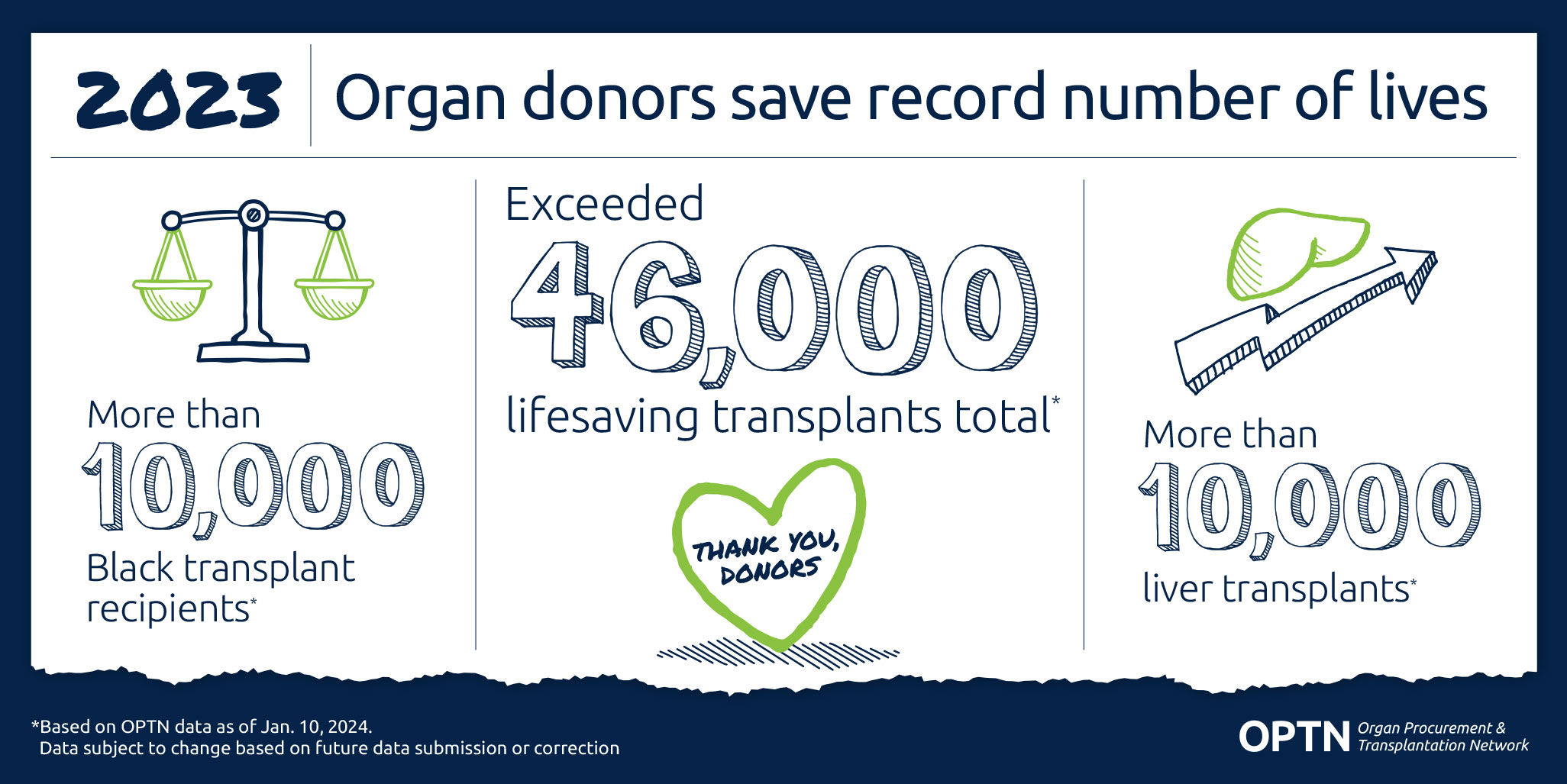Continued increase in organ donation drives new records in 2023; New milestones exceeded
Published on: Wednesday, January 10, 2024

In brief:
- More than 16,000 deceased organ donors, a new annual record and a continuation of a 13-year annual-record trend
- More than 46,000 organ transplants performed, continuing annual record-setting trend
- More than 10,000 transplant recipients were Black, non-Hispanic
- More than 10,000 liver transplants performed for the first time
- More than 3,000 lung transplants performed for the first time
- New annual records also set for kidney and heart transplants
A continued increase in organ donors in 2023 led to a number of annual record-setting trends in the organ transplantation system in the United States, according to preliminary data from the Organ Procurement and Transplantation Network (OPTN). This annual increase led to several new milestones in organ donation, procurement and transplant activity.
A total of 16,335 individuals donated one or more organs upon death. This represents a 9.6 percent increase over 2022 and the first year with more than 15,000 deceased donors. An additional 6,953 people became living organ donors, representing the third highest annual total and the highest since the all-time record in 2019. While the number of living donors varies each year, 2023 represents the thirteenth year of consecutive increase in deceased organ donors nationwide.
“We are gratefully indebted to the generosity of all donors – living and deceased - and donor families, to continue to allow us to help yet more people in need of a transplant,” said Dianne LaPointe Rudow, DNP, president of the OPTN Board of Directors. “At the same time, the community of organ donation and transplant professionals continues to pursue improvements to perform even more lifesaving transplants with the organs that are available.”
Transplant trends
There were 46,632 organ transplants performed from both living and deceased donors in 2023. This represents an 8.7 percent increase over 2022 and a 12.7 percent increase over 2021, which was the first year with more than 40,000 organ transplants. There were 39,679 organ transplants from deceased donors. This represents an 8.9 percent increase over 2022 and marks the eleventh consecutive record-setting year.
There were 6,953 organ transplants made possible by living organ donors, the highest total since 2019 when an all-time record of 7,397 living donor transplants took place. While over 90 percent of living donor transplants are kidney transplants, living donor liver transplants have been increasing steadily for the last few years. There were 658 living liver donor transplants in 2023, which set a new record.
Kidney disease has a disproportionate effect on Black and Hispanic populations. For this reason, they comprise a large share of kidney transplant candidates. The number of transplants for both groups increased in 2023 for kidneys and for all organ types. For the first time, more than 10,000 organ transplants recipients were Black, non-Hispanic (10,824 for all organ types, 8,323 kidney transplants). The total transplants (all organ types) for Black, non-Hispanic recipients increased 12.3 percent over 2022. In addition, for the first time, more than 8,500 transplants were performed for Hispanic/Latino recipients (8,540 for all organ types; 5,407 kidney transplants.) The total transplants (all organ types) for Hispanic/Latino recipients increased 6.5 percent over 2022.
For the first year ever, more than 10,000 liver transplants were performed in 2023. There were 10,660 liver transplants performed, which was an 11.9 percent increase over 2022 and continues an 11-year trend of annual records. In addition, lung transplants exceeded 3,000 for the first time (3,026 total). All-time volume records were also set for kidney (27,329) and heart (4,545) transplants.
Deceased donation trends
In increasing numbers compared to earlier years, deceased donors tend to represent less traditional forms of donation, such as circulatory death (as opposed to brain death) and older age. In 2023, 5,896 (36 percent of total donors) donated after circulatory death, a 40.7 percent increase over the past three years. Separately, 6,884 deceased donors (42 percent of the total) were age 50 or older. The most common age range of deceased donors is 50 to 64 (5,393 in 2023; an increase of 16 percent over 2022).
Living donation trends
While living organ donors tend to be younger on average than deceased donors, the proportion of older living donors is also increasing. In 2023, there were 2,720 living donors between the ages of 35 and 49, the most common age range and an increase of 7.9 percent over 2022. However, 2,495 were age 50 or older, and the rate of increase (12.1 percent) was higher than the 35-49 age group. The third most common age group includes living donors were between ages 18 and 34; there were 1,736 in 2023, an increase of only 1.1 percent compared to 2022.



